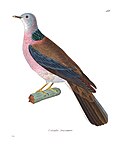| Streptopelia | |
|---|---|
 | |
| A Eurasian collared dove (Streptopelia decaocto) in Adana, Turkey. It is a typical and widespread member of the collared doves. | |
| Scientific classification | |
| Kingdom: | Animalia |
| Phylum: | Chordata |
| Class: | Aves |
| Order: | Columbiformes |
| Family: | Columbidae |
| Subfamily: | Columbinae |
| Genus: | Streptopelia Bonaparte, 1855 |
| Type species | |
| Columba risoria | |
| Species | |
See text | |
Streptopelia (collared doves and turtle doves) is a genus of 15 species of birds in the pigeon and dove family Columbidae native to the Old World in Africa, Europe, and Asia. These are mainly slim, small to medium-sized species. The upperparts tend to be buffy brown and the underparts are often a shade of pinkish-brown, and they have a characteristic black-and-white patch on the neck. They have cooing or purring songs, monotonous in some, restful and soothing in others. The genus divides into two groups, the collared dove group (11 species) with uniform upperparts and a black half-collar edged with white, and the turtle dove group (4 species) with patterned upperparts and a barred side panel on the neck. They range in size from the 20–23 cm red collared dove to the 33–35 cm oriental turtle dove. Most of the species are resident or disperse over short distances, but two (the European and Oriental turtle doves) are long-distance migrants breeding in temperate areas and wintering in the tropics. The sexes are not differentiated in most of the species, except for the red collared dove, where the males are orange-red with a greyish head, and the females a duller brown. [1]
Contents


As a group, this genus is highly successful; several species are abundant in a range of habitats in the tropics, with three species having a more extensive distribution into temperate areas as well. The Eurasian collared dove (Streptopelia decaocto) in particular has expanded naturally out of its original range of the warmer temperate regions from southeastern Europe to India to colonise the rest of Europe, reaching as far west as Great Britain by 1960 and Ireland soon after, and also east across northern China to Japan. It has also been introduced into the Americas where it has now colonised most of North America, Central America, and the Caribbean, and is still spreading rapidly. Some other species have been less successful in recent years, with two species listed by IUCN as Vulnerable. [1]














